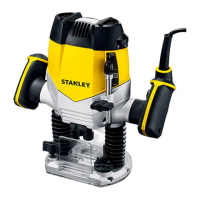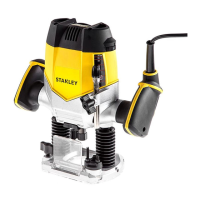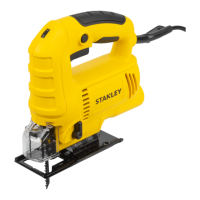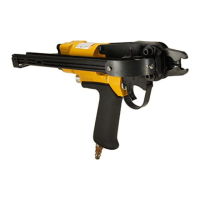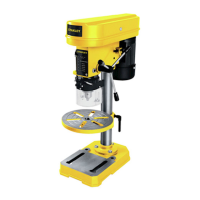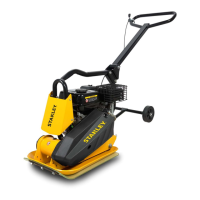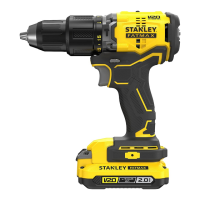8 • ENGLISH
do the job better and safer at the rate for which it was
designed.
b. Do not use the power tool if the switch does not
turn it on and off. Any power tool that cannot be
controlled with the switch is dangerous and must be
repaired.
c. Disconnect the plug from the power source and/or
the battery pack from the power tool before
making any adjustments, changing accessories,
or storing power tools. Such preventive safety measures
reduce the risk of starting the power tool accidentally.
d. Store idle power tools out of the reach of children
and do not allow persons unfamiliar with the power
tool or these instructions to operate the power
tool. Power tools are dangerous in the hands
of untrained users.
e. Maintain power tools. Check for misalignment
or binding of moving parts, breakage of parts and
any other condition that may affect the power
tools operation. If damaged, have the power tool
repaired before use. Many accidents are caused by
poorly maintained power tools.
f. Keep cutting tools sharp and clean. Properly
maintained cutting tools with sharp cutting edges are
less likely to bind and are easier to control.
g. Use the power tool, accessories and tool bits
etc., in accordance with these instructions and
in the manner intended for the particular type
of power tool, taking into account the working
conditions and the work to be performed.
Use of the power tool for operations different from
those intended could result in a hazardous situation.
5. Service
a. Have your power tool serviced by a qualified
repair person using only identical replacement
parts. This will ensure that the safety of the power
tool is maintained.
6. Electrical safety
Your tool is double insulated; therefore no earth
wire is required. Always check that the main
voltage corresponds to the voltage on the rating
plate.
Warning! If the power cord is damaged, it must
be replaced by the manufacturer, authorized
Stanley Service Center or an equally qualified
person in order to avoid damage or injury. If the
power cord is replaced by an equally qualified
person, but not authorized by Stanley, the
warranty will not be valid.
7. Labels on tool
The label on your tool may include the following symbols:
FEATURES (Fig. A)
1. Switch
2. Heat control knob
3. Ventilation slots
4. Nozzle
Intended Use
Your Stanley heat gun has been designed for various
heating applications (eg. Paint stripping)
Additional Safety Instructions for Heat Guns
f Always switch off before putting tool down.
f Extreme care should be taken when stripping
paint, the peelings, residue and vapors of paint
may contain lead, which is poisonous. Once
deposited on surfaces, hand to mouth contact can
result in the ingestion of lead. Exposures to even low
levels of lead can caused irreversible brain
and nervous system damage; young and unborn
children are particularly vulnerable. Do not smoke,
eat or drink in a work area that could or may be
contaminated by lead. Lead based paints should
only be removed by a professional and should not
be removed using a heat gun. When removing
paints you should ensure that your work area is
enclosed. It is advisable to wear a dust mask.
f Do not burn the paint. Keep the nozzle at least
25mm (1”) from the surface as this keeps the
temperature below the required 450°C. If you are
scraping from a vertical position then you should
scrape downwards to prevent the paint from falling
back into the heat gun and burning. Dispose of all
paint debris safely and ensure that the work area is
thoroughly cleaned after completing the job.
f Do not use in a damp atmosphere or where
flammable gases may be present or use near
combustible materials. Spaces behind boards,
ceilings and floors and wall cavities in timber frame
constructed houses can contain flammable materials.
Check before using the heat gun.
f Allow the tool to cool fully before storing.
f Ensure adequate ventilation when using heat guns
as toxic fumes may be produced.
Read
Instructions
Manual
Use Eye
Protection
Use Ear
Protection
V ........ Volts
A ........ Amperes
Hz ....... Hertz
W ........ Watts
min ..... minutes
..... Alternating
Current
..... Direct
Current
n
0
....... No-Load
Speed
...... Class II
Construction
.... Earthing
Terminal
.... Safety Alert
Symbol
.../min.. Revolutions
or Recipro-
cation per
minute
